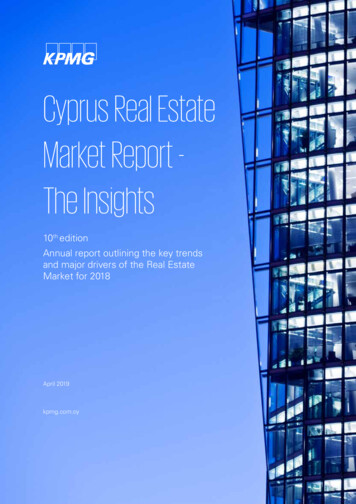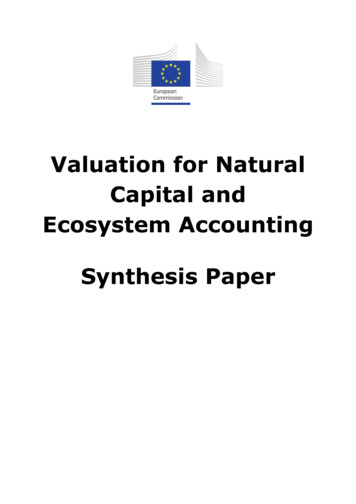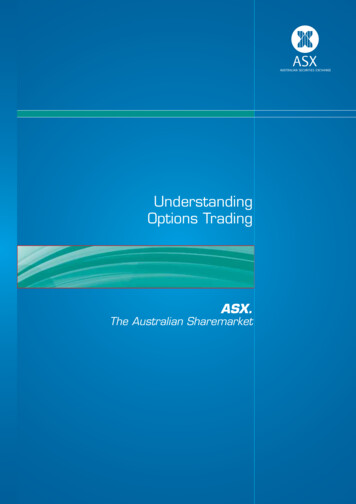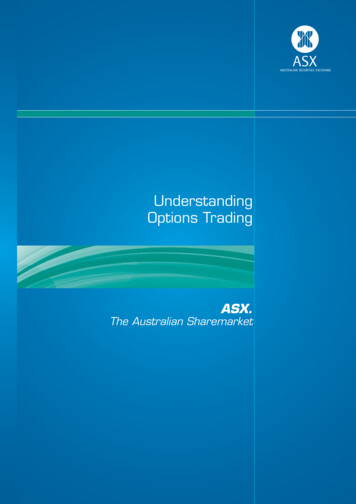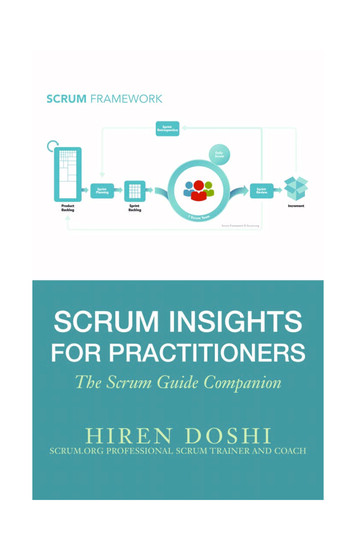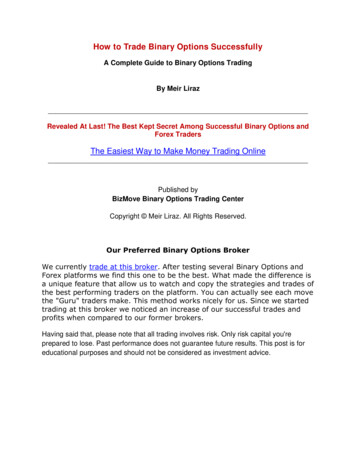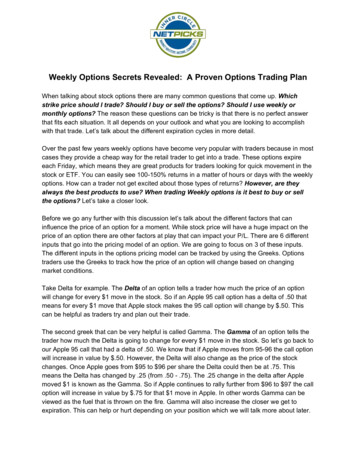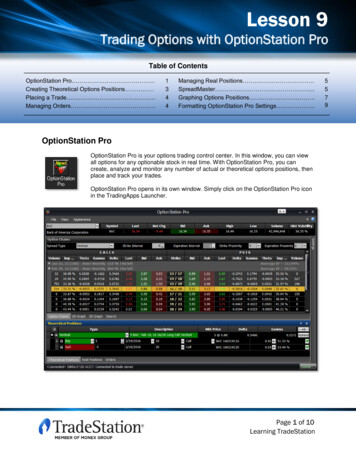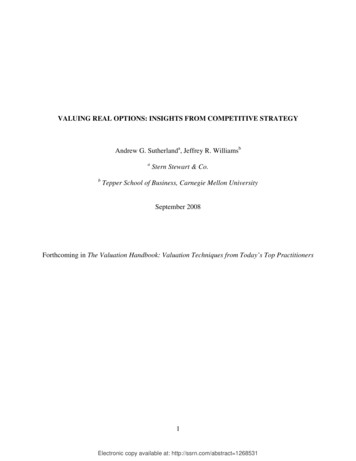
Transcription
VALUING REAL OPTIONS: INSIGHTS FROM COMPETITIVE STRATEGYAndrew G. Sutherlanda, Jeffrey R. WilliamsbabStern Stewart & Co.Tepper School of Business, Carnegie Mellon UniversitySeptember 2008Forthcoming in The Valuation Handbook: Valuation Techniques from Today’s Top Practitioners1Electronic copy available at: http://ssrn.com/abstract 1268531
INTRODUCTIONGrowth opportunities and future strategies can comprise a significant proportion of a firm’svaluation. At the end of 2006, the median company in the S&P 500 and Russell 3000 had 25%and 40% of their valuation, respectively, attributed to Future Growth Value (FGV ), thecapitalized value of future profit growth1. Acquisition premiums can also be interpreted asestimates of value creation attributed to new tactics and operational improvements under a newregime. Unfortunately, managers often find static Net Present Value tools and trading multiplesto be too rigid to evaluate the contingent nature of strategic decisions and the cash flow recoveryprofiles associated with possible outcomes. For example, Microsoft was willing to develop itsXbox platform at a loss because it expected subsequent game and peripheral offerings linked to itto generate significant profits. Similarly, commodities producers frequently choose to delayextraction until output prices swing in their favor. Academics and practitioners have recognizedthe similarities of payoff functions between such contingent decisions about real assets, classicexamples of “real options,” and those of financial securities whose value is derived from theprice of something else. The Black-Scholes model and Binomial Lattices have emerged as themost frequently prescribed and used tools for evaluating real options within both capitalbudgeting and enterprise valuation contexts. With the classic real option decision growingincreasingly complex, and managers becoming more sophisticated, a frank assessment of modernvaluation tools is timely.Section I provides an overview of commonly used approaches for pricing contingent claims onfinancial securities. Section II reviews how practitioners and academics have extended these1FGV is calculated as Enterprise Value – Capital in place – Current Year’s EVA /WACC.S&P data for the 2006 year end was downloaded from Bloomberg; and Russell 3000 and WACC data pulled fromThe 2007 Russell 3000 EVA/MVA Annual Ranking Database2Electronic copy available at: http://ssrn.com/abstract 1268531
approaches to the basic application of real option pricing. Section III, the core focus of thischapter, scrutinizes the assumptions made in the extension of models built for financial securitiesto real projects. A number of refinements are presented that attempt to better address the strategicrealities of the firm and, in doing so, generate a more robust valuation. A summary anddiscussion of areas of future research conclude the chapter.I. OVERVIEW OF OPTION PRICING FOR FINANCIAL SECURITIESOptions give an investor the right, but not the obligation, to buy or sell a security according topredetermined terms during some period or at some specific point. Stock option contracts can bedivided into two categories: calls and puts. A call option gives the holder the right to purchase(“call”) stock from a counterparty at a fixed exercise price at or before a specific date. A putoption gives the holder the right to sell (“put”) stock to a counterparty at a fixed exercise price ator before a specific date. At contract expiry, the call holder makes money when the price of theunderlying is above the exercise price, while the opposite holds for the put holder. When theexercise is only permitted upon option contract expiry, it is termed “European”; when exercise ispermitted at any point up to and upon expiry, it is termed “American”. Figure 1 depicts thepayoff function for call and put option positions where the exercise price is 100.Figure 1: Payoff Diagrams for Stock OptionsStock options can serve a number of important purposes:3
1. Given their low price relative to the underlying stock, call and put options can be used tomake a leveraged bet on future returns. For the same up-front cost as a single stock, anumber of call options can be purchased, resulting in more than a dollar-for-dollar changein wealth for each dollar change in stock price.2. Call and put options can provide an inexpensive way to hedge positions in firms withsimilar exposures, or holdings in the stock itself. Investors locked into a long position ina stock can get insurance on their position by purchasing a put option.3. Finally, call options are instruments frequently used in executive compensation to alignthe long-term interests of management and the firm. For example, Table 1 shows FedExdisclosed in its 2007 Annual Reporti the granting of options to its management.Table 1: FedEx Option GrantsOptions contracts are written on all sorts of other underlying assets and variables such as bonds,interest rates, exchange rates, and commodities. They also have been tailored in their mechanics,with options termed Asian, Barrier, Bermuda, and Digital characterizing different payoff rules.4
The Black-Scholes ModelThe growth of innovation and volume in option trading has coincided with advances in pricingapproaches for stock options. One of the most influential approaches was published by FischerS. Black and Myron S. Scholes in 1973. The “Black-Scholes” model employed GeometricBrownian Motion, a domain of stochastic calculus, to simulate the price path of the underlyingstock. Options had been traded on exchanges as far back as the 17th century, but Figure 2 showsit wasn’t until after the Black-Scholes model and equally important research by Robert C.Merton (1973) was published that the market truly took off.Figure 2: Size of the Derivatives Market*Source: International Swaps and Derivatives Association. Figures include interest rate swaps, currencyswaps, credit default swaps, and equity derivatives.The Black-Scholes model prices stock options with five variables: The price of the underlying (S) The exercise (“strike”) price (X) The risk-free rate (r) The option contract horizon, in years (T) The annual return volatility of the underlying (σ).Figure 3 summarizes how the option value responds to changes in the above variables.5
Figure 3: Drivers of Option ValueConsider the logic behind the valuation relationships in Figure 3. The right to buy (call) stock isworth more when you have to pay less than what it’s worth; and the right to sell (put) stock isworth more when you are entitled to receive more than what it’s worth. This refers to theintrinsic value of the option, or the current spread between the stock and exercise price. Sinceoption contracts endow a right but not an obligation of exercise, having a more uncertainunderlying price path increases the possible upside, while the potential downside (you forfeit thecost of the call when exercise is not worthwhile) remains limited. Finally, having more time toenjoy price swings in your favor increases the value of the option to you. Black-Scholessynthesizes the relationships between these inputs to produce European call (C) and put (P)option values as follows:C S* N ( d 1 ) X * e rt * N ( d 2 )P X *e rt *N ( d 2 ) S * N ( d 1 )Whered1 [ln( S / X ) ((r σ 2 ) / 2)t ] / σ * tandd 2 d1 σ * T6
One significant finding of Black and Scholes is that there exists a relationship between the optionvalue, the current value of the underlying stock, and the return on a risk-free security. The “putcall parity” relation isC X * e rt P SExercise 1:a) Price a European call option issued on stock with an exercise price of 15, value of 13,annual return volatility of 25%, and horizon of one year. Assume the risk-free rate is 5%.b) Use the put-call Parity relationship to price a put option on the same stock.c) Another one year European call issued on a different stock is priced at 1.20. It has anexercise price of 20, a current value of 17, and the risk-free rate is still 5%. Use theBlack-Scholes model to calculate the annual return volatility implied by the current price.Solution:a) 0.81b) 2.08c) 28.74%The configuration of the Black-Scholes model shown above assumes no dividends are paid onthe underlying stock. When dividends are paid, call option holders suffer because they don’tparticipate in the payment, and the underlying stock price falls by approximately the amount ofthe dividend. For this same reason, put holders are better off—the spread between the exerciseand underlying price increases. Figure 4 outlines the effect of dividends on call and put optionvalues.7
Figure 4: Option Valuation When Dividends Are PaidTo handle cases where the underlying stock has a non-zero dividend yield, the Black-Scholesmodel can be applied as follows:C S * e yt * N (d1 ) X * e rt * N (d 2 )Where y equals the annual dividend yield (the dividend divided by S), and d1 and d2 now equald1 [ln( S / X ) ((r y σ 2 ) / 2)t ] / σ * td 2 d1 σ * TThe value of the put can be determined using the same put-call parity relationship for nondividend-paying stocks outlined earlier. Note that the dividend yield represents a continuouspayment; consistent with the time mechanics assumed in the Black-Scholes model.Exercise 2:a) Refer back to the excerpt of the FedEx annual report at the beginning of this section. Usethe horizon, volatility, risk-free rate, and dividend yield assumptions from the 2007column to price a call option on FedEx stock issued “at the money” (S X) when the stockis worth 108.75.Solution:a) 31.578
Binomial LatticesWhereas the Black-Scholes model applies continuous time dynamics, Binomial Lattices usediscrete time dynamics. This approach, developed by Cox, Ross, and Rubinstein (1977), isparticularly useful for analyzing the effects on option values of one-time events such asbankruptcies or mergers; and recurring events such as quarterly dividends; in addition tomodeling the American option exercise. The same five variables (price of the underlying, strikeprice, risk-free rate, option contract horizon, and return volatility of the underlying) play a role invaluing the option. In fact, as the Binomial Lattice is geared with smaller and smaller timeincrements, the option price will converge to the Black-Scholes value.A Binomial Lattice works as follows. The period leading up to option expiration is split intosubperiods, marked by “nodes.” Price discovery for the underlying occurs at each node—thestock rises or falls by a specific amount depending on its return volatility. The stock increasescalar “u” which set the magnitude of the price rise is equal to eσ t and the stock decrease scalar“d” equals 1 / u . Readers familiar with decision trees will recognize the mechanics of thisframework, presented in Figure 5.Figure 5: Simple Binomial Lattice for Stock9
Exercise 3:a) Using the volatility assumptions of Exercise 1a), model the price path of the stock for oneyear using a Binomial Lattice with nodes every three months.Solution:a)Once the price path of the underlying has been simulated, the option can be valued at eachending node. The option is worth the greater of S-X and 0 (given the investor can choose not toexercise).For the call option, the value is the greater of 0 and S-X: for the put option, the value is thegreater of 0 and X-S.10
The option value today is then estimated by working recursively through the tree, assuming riskneutrality. This means that future payoffs are discounted at the risk-free rate, where theprobability of a “u” step in the underlying is:pu [e ( r y ) d ] /(u d )And the probability of a “d” step is simply 1 puThe value of the options at each of the second-to-last nodes can be calculated:For each node prior to the second-to-last node, using the same recursive approach:When the stock pays a discrete dividend (as the vast majority of dividends are paid in practice), itcan be modeled in the lattice by simply subtracting the dividend from the underlying when it ispaid.11
Exercise 4:a) The stock from Exercise 3 pays a dividend of 0.10 at the end of each quarter.Recalculate the price path of the stock using the Binomial Lattice approach.b) How does the new price path change the value of the call option?Solution:a)b)The call is worth 0.13 less.II. BASIC OPTION PRICING APPLICATIONS FOR REAL ASSETSThe pricing tools for call and put options have been extended to the valuation of all sorts of othercontracts including interest rate derivatives, futures contracts, and exotic variations of vanilla12
calls and puts. Largely because of the explicit modeling of state-dependent decisions, they havealso proven useful for evaluating real options, where the firm holds the right but not theobligation to make some business decision. Traditional valuation approaches such as NPV andInternal Rate of Return are useful for applying to the “as-is” perspective of the firm. However,the total worth of a firm comprises not just the value of the current operations, but also the valuederived from the ability to expand projects progressing successfully; abandon ones revealingthemselves to be unsuccessful; and take advantage of the learning, information, and marketposition gained in both scenarios. Net Present Value (NPV) and Internal Rate of Return (IRR)analyses often are too rigid to maneuver the dynamic and flexible nature of such strategicoptions.The classic capital budgeting exercise involves discounting expected cash flows at an appropriaterisk-adjusted rate. When only point estimates of the most likely scenario are used in valuation;and the payoffs from dynamic and flexible strategies are ignored or improperly measured; thevaluation exercise is incomplete (Myers 1977, 1984). How can the ability to expand, abandon,and collect information be priced? What is the conceptual connection to the options framework?Production Flexibility and Platform InvestmentsLet’s start with a call option. There are many situations where possessing the right, but not theobligation, to make a production or investment decision creates value for the firm. Consider theinvestment and extraction opportunities of an oil company. While spot (current) market pricesare a major determinant of project valuation, the possibility of delaying production until pricesmay be higher can be a material source of value as well. The greater the uncertainty in the output13
market, the more the right to delay is worth. The value of this flexibility, combined with thepresent value of the project in current conditions, can be compared to the fixed investment cost.A manufacturer may look at its capacity decisions with a similar perspective. Maintaining excesscapacity or inventory can allow the firm to capture enormous profits during periods of peakdemand that more than offset holding costs and the opportunity cost of the capital tied up.Yet another analogy can be made to companies that invest significant amounts in intangibleassets. Much of their focus is on searching for growth opportunities where platform investments,often developed at considerable expense, spawn profitable offspring. For example, Microsoft’sownership of the Windows platform allowed them to develop follow-on products such as theOffice software, MSN Messenger application, and subsequent versions of Windows. HadMicrosoft overlooked the value of follow-on products and made the decision to develop the firstWindows product based solely on its stand-alone profits, the company might not have investedso heavily or placed so much faith in the development of what would be one of the richest realoption platforms in history. Note that Microsoft succeeded with another platform investment inthe Xbox video game system, sold at a considerable loss (as described in Figure 6), expecting tomore than recover through the sale of games and hardware that are linked exclusively to thesystem (Ivan, 2007).14
Figure 6: Xbox’s Real OptionsInformation and Organizational LearningThere are scenarios in which the information revealed or the organizational learning following adecision can be used to maximize the potential of platform investments. Sometimes theuncertainty surrounding the future success of a new product release can be managed in such away to make even the biggest “Hail Mary” of offerings worth taking on. A film studio can phaseits investments in advertising, distribution, and development of sequels for a movie by staging itsexpenditures; pending the reaction of critics and other viewers at early screenings. While newreleases tend to have a low probability of success, successful releases generate vast payoffs notjust from screening revenues, but DVDs, merchandise, and sequels. Therefore, being able toaccelerate or decelerate spending after the results of early screenings are known is like letting thestudio participate in a real options lottery, and keeping the cost of their participation at aminimum. Figure 7 provides a hypothetical investment decision roadmap for film studios.15
Figure 7: Real Options Embedded in a Film ProjectThe investments made by a pharmaceutical company can be thought of in terms of embeddedreal options as well. Like the film studio, it can similarly stage spending- in this case theresearch and development of drugs, pending clinical trials and regulatory approval. Furthermore,it attaches value to learning, often firm-specific and proprietary, that occurs even when a givenproduct fails to make it to market. The research and development for one project may generateknowledge and capabilities useful for others that would not have necessarily been enjoyed hadthe initial project not been carried out. Breakthroughs and patents spawned from a losing effortcan be applied to support related projects, and mistakes made in previous trials avoided.Project Abandonment as an OptionThe right to abandon or scale back an investment is also worth something to the firm, and this iswhat typifies the put variety of real options. Take a minerals company that gets hit with anextended period of declining prices for its output. Rather than continue to operate at a loss, it cansell its property and equipment, and use the proceeds to invest elsewhere. There are many16
analogous situations in which shutting down a business that runs into hard times is a much betteralternative to “letting it ride.”Each of the investment scenarios above can be characterized by a common element. Being ableto make or unwind an investment at a future date, pending the realization of some event, is avaluable right. When relating the realization to the price path of the underlying security for a callor put option, the analogy between the real investment and the financial derivative, for thepurpose of real option pricing, is complete. To the extent one can model the variables thatdetermine the value of the investment—be it the price path of oil, the popularity of a movie, orthe success of follow-on projects—the Black-Scholes or Binomial Lattice framework can beapplied. The remainder of this section demonstrates how the tradeoffs between the benefits andcosts of investment flexibility and information are quantified in each of these frameworks.Using the Black-Scholes Model to Value Real AssetsRecall the example of the oil company that possesses reserves, and thinks about market pricevolatility in timing extraction. This situation naturally extends itself to Black-Scholes valuation.The inputs originally taken from the opportunity to invest in a financial security can be drawnfrom the characteristics of the real investment opportunity as illustrated in Figure 8.Figure 8: Real Option Valuation Drivers Using Black-Scholes17
The option values (calls and puts) are added to the static NPV in determining the total worth ofthe investment.Exercise 5:a) Consider an oil company with 400,000 barrels of known reserves. They can extract andproduce the reserves a
Stock options can serve a number of important purposes: 4 1. Given their low price relative to the underlying stock, call and put options can be used to . column to price a call option on FedEx stock issued “at the money” (S X) when the stock is
